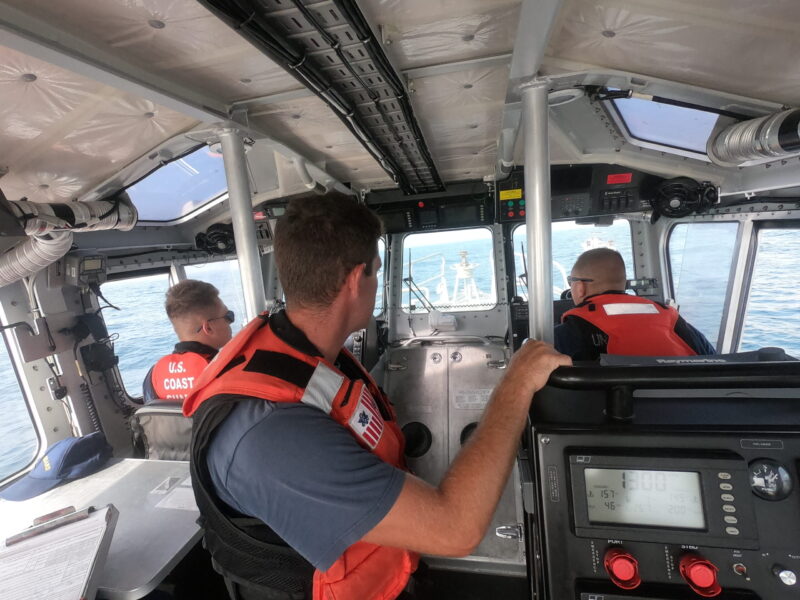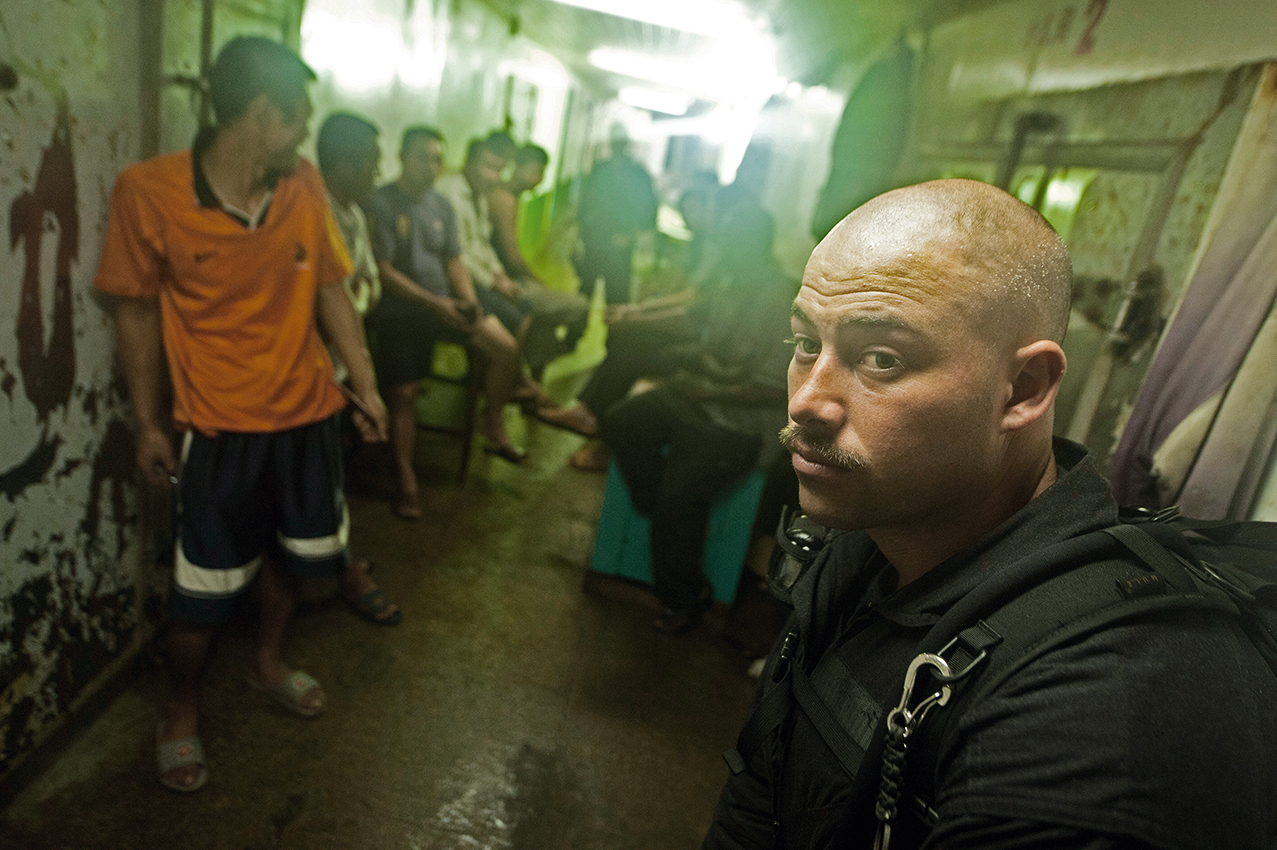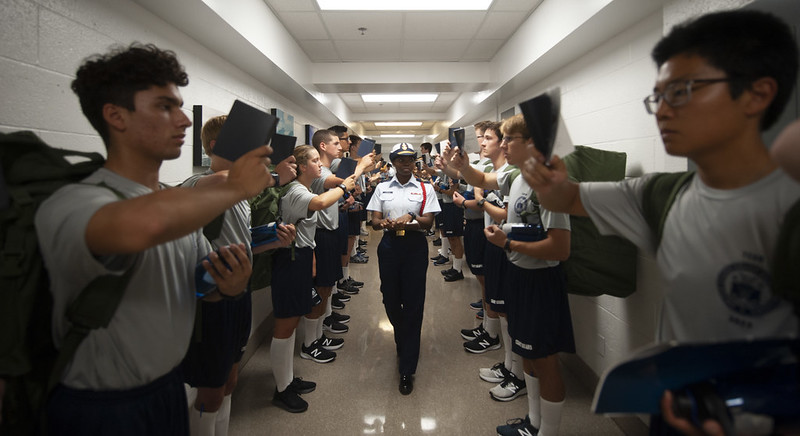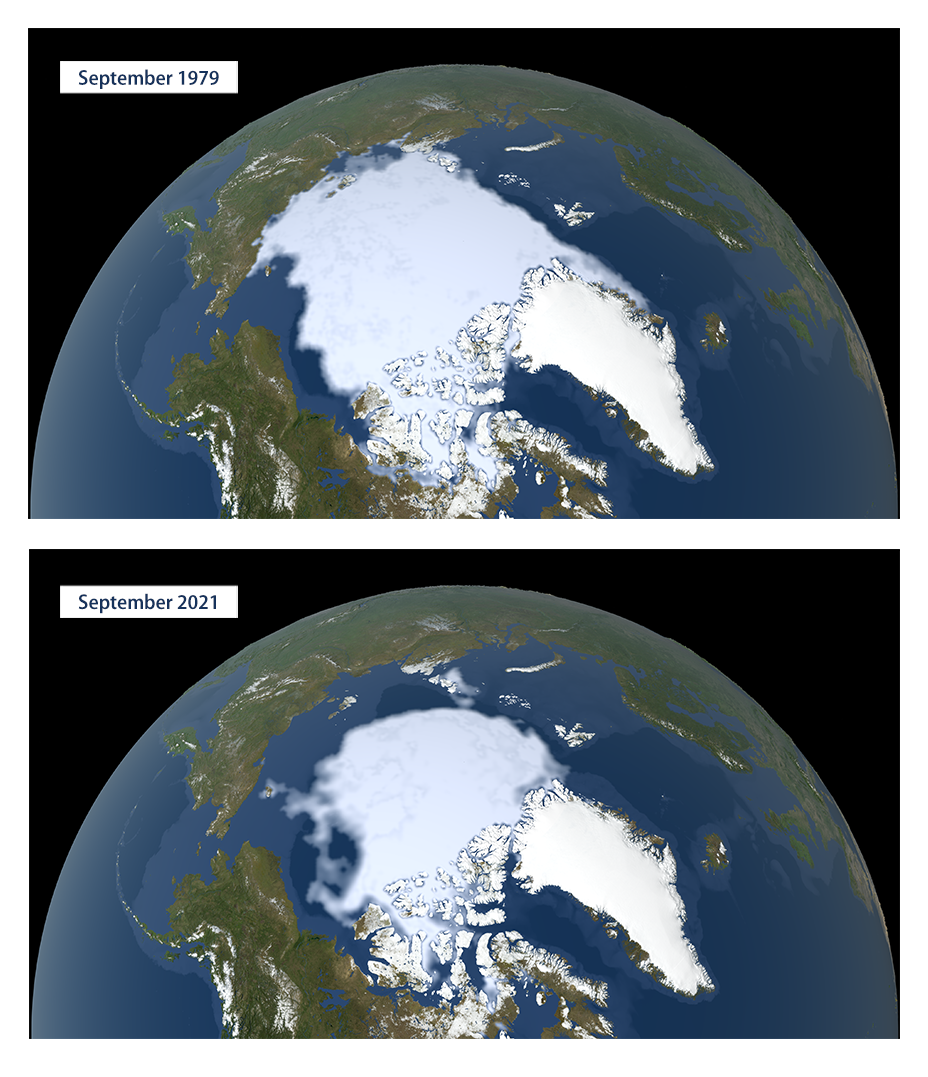SEMPER PARATUS: Always Ready
U.S. Coast Guard tackles emerging marine resource and national security issues
By Meredith HaasUNLESS IN ACTUAL NEED OF BEING RESCUED, most boaters may not relish the sight of an approaching U.S. Coast Guard (USCG) boat—wondering if they’ve done something wrong.
More often than not, it’s a friendly safety inspection, but for those who are fishing illegally in federal waters, a visit from the Coast Guard is less than ideal. Such activity has grown over the years as the Southwest Ledge off Block Island has become a premier fishing ground for large striped bass, an area that mostly lies in protected federal waters where it is illegal to fish them.
“There’s been more poaching in the area, so we’re really trying keep a thumb on that,” says USCG Petty Officer Matthew Cavaco, as he and his four-member crew gear up for another early morning patrol before the sun is up. “We’ve got to keep up a presence out here.”
It’s the beginning of August at 5 a.m., and a steady stream of mostly recreational fishers leave Galilee and head towards Block Island, where fishing, like the weather, has been on a hot streak for everything from striped bass and fluke to bluefish, scup, and black sea bass.

USCG Petty Officer Matt Cavaco and his team patrol Block Island Sound for illegal fishing activity. Photo by Meredith Haas
It’s not just about the fish. It’s more than that.
The 45-foot Coast Guard response boat follows in the same direction through the thick fog, leaving behind the eerie glow emanating from the Galilee docks. Cavaco says he and his crew have been more diligent about monitoring this area to deter poaching since last year, when they issued several thousand dollars’ worth of fines to fishermen that were pulling striped bass from federal waters, where federal violations come with a penalty of up to $1,000 for each fish.
Protecting marine resources is one of the Coast Guard’s primary missions that distinguishes it from other military branches, and protecting striped bass and other species vulnerable to overfishing that could compromise their populations falls within that mission.
As the rising sun broke up the fog, Block Island and its famous wind farm came into plainer view as did more than a dozen or so recreational fishing boats. At the sight of the Coast Guard, many moved their position to make sure they were fishing within the 3-mile limit of the shore, keeping them in state waters. Over the course of several hours, only a few boats had lures out that seemed intent on catching striped bass either knowingly or unknowingly in federal waters, though none had produced any catches.
“Obviously we want to protect the fisheries, but we also want to build rapport with the community,” says Cavaco, explaining how educating boaters on safety is an important part of their work, too, especially at a time of year when more accidents occur on the water. “I’ve had to pull more kids out of the water than I care to.”
But whether they’re monitoring recreational or commercial fishing vessels or conducting safety inspections, these efforts for him are also about mentoring and motivating newer members of his crew, such as the three on this patrol. Cavaco says he wants to instill in his crew an understanding of the greater purpose of their mission to protect marine resources and safeguard the community on the water.
“It’s not just about the fish. It’s more than that.”
While Cavaco and his crew, who are stationed at Point Judith, may only be charged with patrolling the waters off Rhode Island, their training and efforts are enveloped into the Coast Guard’s mission that extends well beyond federal waters. Best known for their search and rescue missions, the Coast Guard has 11 missions centered around maritime safety, marine conservation, and national security. Unlike other branches of the military that are more combat-oriented, the Coast Guard plays a critical role in enforcement and search and rescue on the water—both domestically and abroad.
And many of these broader missions are accomplished via USCG cutters that are 65 feet or longer in length, which can support multiple missions.
“I was drawn to the Coast Guard because it’s more humanitarian-focused and has more mission sets that are environmentally tailored,” says Ensign Madeline Kaller, who is currently stationed in Charleston, South Carolina, aboard the USCG Cutter Stone, which, Kaller says, has “the capability to pursue eight out of those 11 missions.” Kaller, who graduated from the Coast Guard Academy last year, just returned from a two-and-a-half month patrol in the Caribbean and the South Pacific, where the Coast Guard conducted several different types of operations aboard Stone.
“We were [monitoring] illegal fishing but then could also flip a switch and focus on drug interdiction,” she says. “It’s kind of like a taste of everything.”
The Coast Guard is the only agency able to enforce federal regulations, such as fisheries and safety inspections, in U.S. federal waters and is the only agency able to enforce international laws on the high seas and where cooperative agreements are made with other countries like Ecuador or Ghana, which often lack resources. And as the ocean continues to change with shifting climate conditions and new and increased uses of ocean spaces, the Coast Guard is refocusing its efforts and resources.
“My first tour was like drinking from a firehose,” says USCG Officer Tara Pray, describing how when she first went afloat nearly 10 years ago, there was a lot of learning on the job in the various missions.
Pray, who currently acts as the Coast Guard Liaison to the U.S. Department of State and who is a recent Marine Affairs graduate from the University of Rhode Island, says that her initial patrols were either in the Northeast, focusing on living marine resource protection, such as fisheries inspections, or in the Florida Straits, conducting migrant interdiction missions.
“Now, you’re seeing this huge shift towards IUU [illegal, unreported, and unregulated fishing] and the Arctic strategies,” she says, referring to the Coast Guard’s increased efforts in these areas.
Focus on IUU Fishing
Unlike standard commercial fishing, IUU fishing means fishing without a license or in a closed area, such as in marine sanctuaries, or using prohibited gear, such as drift nets or explosives to catch fish. This also includes fishing above a set quota or fishing prohibited species such as sharks or Chilean sea bass.

US Coast Guard checking fishing permits from recreational fishers off Block Island. Photo by Meredith Haas
The crew of the Oliver Berry travel in a round-trip patrol from Sept. 12 to Oct. 27, 2020, from Hawaii to Guam, covering a distance of approximately 9,300 miles during their journey.
The crew sought to combat illegal fishing and other maritime threats across the Pacific to protect the United States and our partner’s resource security and sovereignty.
U.S. Coast Guard photo courtesy of the CGC Oliver Berry
But it also refers to fishing activities that are not reported or are misreported, or where there are no applicable conservation or management measures for a particular area or fish stock. This is not to be confused with standard fishing patrols like Cavaco and his crew conduct within U.S. waters, says Pray.
“Fisheries patrols are really ensuring compliance with federal laws and regulations in terms of gear and catch,” she explains, adding that it’s important to make the distinction between these standard patrols and IUU fishing as two different types of fisheries-based enforcement roles of the Coast Guard.
IUU fishing has become a prominent focus for the Coast Guard in recent years since the passage of the Maritime Security and Fisheries Enforcement Act in 2019, says Pray. Under this law, the USCG jointly leads efforts with the U.S. State Department and the National Oceanic and Atmospheric Administration (NOAA) to counter IUU fishing and related threats to maritime security. IUU fishing has replaced piracy as the leading global maritime security threat, according to former USCG Commandant Admiral Karl Schultz.
If IUU fishing continues unchecked, we can expect deterioration of fragile coastal States.
“If IUU fishing continues unchecked, we can expect deterioration of fragile coastal States and increased tension among foreign-fishing Nations, threatening geo-political stability around the world,” he wrote in the USCG’s 2020 strategic outlook report.
In a recent memorandum issued by the White House, IUU fishing has been recognized as one of the “greatest threats to ocean health” by harming the stability of marine ecosystems as well as the stability of global fisheries and food supply—undermining the country’s economic and national security. As the only enforcement agency, the Coast Guard works with domestic and international partners by adding much needed surveillance capacity.
Cooperative agreements with other nations have allowed the Coast Guard both the authority and capability to enforce international law on the high seas, which includes everything from drug and human trafficking to IUU fishing, which are often linked. Weak fisheries laws and/or capacity to enforce laws have led some countries to be more vulnerable than others to exploitation by industrial trawlers from other nations.
West African countries, for example, have lost over $200 billion to illegal fishing by vessels linked to foreign nations, amounting to 40-65% of the legally reported catch in West Africa alone, according to a report by The Maritime Executive. As part of the United States Africa Command, the Coast Guard works with other U.S. military branches and regional partners to provide training and support to combat IUU fishing.
“When you look around the world at some of the challenges that the … democratic order is facing … in so many places there is this creeping undermining of the rule of law,” says Dr. Rebecca Pincus, an Assistant Professor in the Strategic and Operational Research Department at the U.S. Naval War College in Newport, who previously served for four years conducting research at the USCG Center for Arctic Study and Policy while teaching at the Academy.
She explains that China, specifically, is the world’s worst offender for IUU fishing and operates a highly destructive fleet that takes advantage of coastal nations that struggle to enforce fisheries laws or regulations. And helping these nations defend their resources is an important function of the Coast Guard.
“It’s in all of our interests for the rule of law to be sustained at sea around the world…And the Coast Guard is at the forefront of that and will be more and more, I think, this century…it’s sort of a nexus or constellation of missions that align with national security and environmental values…that’s really exciting in ways that maybe weren’t necessarily as visible 10 or 20 years ago, when we didn’t think about IUU fishing as much as having these geopolitical and geo-security dimensions. And so, the ability for the USCG to go in and partner with coastal nations to help defend their living marine resources, help defend their fisheries, help prevent pollution, help combat slavery at sea; that has enormous benefits for the U.S. and the community of nations around the world.”

U.S. Coast Guard Seaman Daniel Rinell, a boarding team member from the Coast Guard Cutter Forward, stands guard over a group of fisherman during a joint U.S. and Sierra Leone law enforcement boarding on the fishing vessel Aya in the Atlantic Ocean June 26, 2011.
The Forward is on a scheduled deployment in West Africa supporting the Africa Partnership Station, (APS) which aims to strengthen global maritime partnerships through training and other collaborative activities in order to improve maritime safety and security in Africa. During the deployment, the Forward crew will work with host nation law enforcement teams to increase awareness and deter illegal fishing off the coast of West Africa.
U.S. Coast Guard photo by Petty Officer 2nd Class Annie R. B. Elis.
Kaller, too, saw the effects of China-supported IUU fishing in the Pacific and says that the Coast Guard is helping “build very good international relations with our partners … if we’re helping them preserve their fish stocks, especially from offenders like China,” she says.
Samira Abdulai Yakubu, a visiting United Nations Nippon Foundation Fellow at URI, is studying policy frameworks at uri to support her role in combating IUU fishing as a fisheries manager for the Fisheries Commission of Ghana.
“We do not have the logistics in terms of capacity. So, to have [the U.S government] impart knowledge [and support] is helping put us in the right direction.”
About 1 in 5 fish taken from the ocean is stolen, according to the NOAA, which adds up to an estimated 26 million tons of fish annually or 1,800 pounds of fish illegally fished every second. A report by the U.S. International Trade Commission in 2019 estimated that the country imported $2.4 billion worth of seafood from IUU fishing and that the elimination of IUU fishing would increase the total operating income of the U.S. commercial fishing industry by $60.8 million.
The report identified China, Russia, Mexico, Vietnam, and Indonesia as “relatively substantial exporters” of illegally caught seafood to the U.S. The Trade Commission also found that over 13% of wild-caught seafood imports were derived from IUU fishing, which was most damaging to U.S. commercial fisheries that target warmwater shrimp, sockeye salmon, bigeye tuna, and squid.
This has implications locally as the Port of Galilee in Point Judith is one of the largest ports on the East Coast and is known for high volumes of squid landings valued at $103.3 million as of 2021, according to the Rhode Island Department of Environmental Management’s Fisheries Report.
The Town Dock, a major seafood wholesaler located in the Port of Galilee, is the largest purchaser of U.S. domestic East Coast squid and has joined with other U.S.-based squid producers and suppliers, as well as those in Europe, Canada, and Australia as part of a Squid IUU Prevention Working Group through the Sustainable Fisheries Partnership.
The goal is to prohibit IUU-sourced squid product and labor and human rights abuses in their supply chains.
“We think it’s important to participate because IUU fishing harms those fishermen that are accountable,” says Katie Almeida, The Town Dock’s fishery policy analyst, explaining that the group is in the early stages of tackling a very complex issue. “We understand this is going to take some effort, some of which needs to come from the government in order to support fishermen who can’t take this on by themselves.”
According to a 2014 report by the Marine Conservation Institute, Rhode Island may have lost as much as $24 million in revenue and as many as 400 jobs due to IUU fishing, said Rhode Island Sen. Sheldon Whitehouse in a recent press release. “There’s a lot of work left to do to crack down on illegal fishing practices that pose a threat to our local fishing industry and we are going to keep pushing forward,” he said, responding to a new international agreement that curbs subsidies that contribute to IUU fishing.
But training and enforcement support from the Coast Guard is only one piece of a much bigger solution that’s needed, says USCG Living Marine Resource Officer Jason Holstead, based in Honolulu and is a URI Marine Affairs graduate who has been dedicated to fisheries-based missions his whole 19 years of service.
“We have authority focused in law enforcement, that’s really where we’re trying to push, but it’s not going to solve the problem. I think it takes a holistic approach from the Department of Commerce and NOAA, the Department of State, and the Defense Department to really focus on those economic and diplomatic impacts.”
Shift to the Arctic
IUU fishing could also become an issue in the Arctic region, which holds some of the last relatively untapped resource reserves in the world for minerals and oil and gas, as well as fish species for which the area served as a de facto refuge (e.g., Arctic cod and haddock). What had protected this region from previous exploitation and activity was year-round or “multi-year” ice cover.
The central portion of the Arctic Ocean is considered the “high seas,” which resides outside of the national jurisdiction of any country, says Pincus.
“[Last year], a moratorium on fishing was signed that placed a hold on fishing in the central Arctic Ocean for a period of 16 years, until interested parties can negotiate some kind of fishing regime that is based on science because the fisheries is moving in response to climate change … there’s a lot of science that needs to be done before those fisheries can be opened.”
While conditions are as such that it is still too difficult to operate in this area, there is growing concern about the future ability to enforce the moratorium as ice continues to melt and make remote areas more navigable.
Today, about half as much ice covers the region as in the past, with sea ice melting at a rate of 13% each decade, according to nasa.
This paved the way, literally, for the first commercial vessel to traverse the Arctic’s northern sea route during the winter of 2018–signaling a future of increased maritime activity within the region and raising environmental concerns regarding damage from oil spills, noise, and resource exploitation. It has also raised national security concerns as traffic and activity increases from various countries in a place where there is no real governance.
“The Coast Guard is going to be challenged with … increased use of the oceans,” says Dave Hill, a retired U.S. Coast Guard captain who served over 30 years and is currently adjunct faculty in Marine Affairs at the University of Rhode Island.
He adds that more marine activity in the Arctic will require some sort of enforcement for protecting marine resources and managing resource exploitation, monitoring travel through the area, and search and rescue operations.
“And guess what, we’ve got one polar class icebreaker that works. Talk about a challenge…another [icebreaker] is being built, but we need a whole fleet to operate in the Arctic.”
The outer rim of the Arctic Ocean adjoins eight coastal nations: Canada, Greenland, Iceland, Norway, Sweden, Finland, Russia, and the U.S. As new trade routes open–linking Asia, North America, and Europe–a new fleet is what top officials say is needed to not only limit resource exploitation but to stay competitive with China and Russia.
“We are an Arctic nation,” said USCG Commandant Admiral Linda Fagan in a recent hearing with the House Homeland Security Committee’s transportation and maritime security panel. “Getting the capability and capacity to create an enduring presence in the Arctic, in the waters off Alaska, are absolutely a priority.”
BARROW, Alaska- The U.S. Coast Guard Cutter Healy, a 420 ft. icebreaker homeported in Seattle, Wash., breaks ice in support of scientific research in the Arctic Ocean. The Healy is mid-way through a four month deployment.
U.S. Coast Guard photo by Petty Officer Prentice Danner.
The Arctic has been on the Coast Guard’s radar for quite some time, according to Pincus of the Naval War College, because despite the political discourse, the Coast Guard—like other military branches—hasn’t had the luxury of ignoring climate change.
“The Coast Guard is one of the leading federal agencies in the Arctic, and climate change is unavoidable,” she says. “If you look back at the Congressional testimonies from a series of Coast Guard Commandants—even when climate change was not on the policy radar, when it wasn’t necessarily something Congress wanted to tackle—they have all said, ‘Look, up in the Arctic there is water where there used to be ice, and I have to deal with that because I’m the Coast Guard Commandant’ … Climate change is political in this country, and the Coast Guard, I think, has generally stayed in the areas of bipartisan consensus, but it can’t ignore climate change given its mission set and given some of the emerging areas where it’s operating with increasing urgency like the Arctic.”
Readying the Next USCG Leaders
To contend with new challenges emerging from climate change and evolving uses and technology that alter the ocean landscape and spaces, curriculum at the Coast Guard Academy has been adapted to better prepare future officers and senior leadership.
“When they hired me, they had never before had on the permanent faculty someone who specializes in marine environmental policy,” says Dr. Tiffany Smythe, who joined the Academy’s faculty in 2018 and also serves as adjunct graduate faculty in Marine Affairs and is a Senior Coastal Institute Fellow with the University of Rhode Island.
She explains that while the Academy has always had a strong science, governance, and civics program, the curriculum has changed over the years in recognition of the connection between emerging environmental and national security issues.
“I really try to get the students thinking about the ocean, thinking about the environment … They’re not just ‘environmental issues.’ These are all security issues. These are economic issues,” she says. “To hear the Commandant and senior Coast Guard leaders talk about IUU fishing [for example] and say that it’s not just about fish, it’s transnational threats. It’s international crime. It’s human rights. It’s economic issues. It’s national security issues–we’re talking about great power competitions with the U.S. and China. IUU fishing is caught up in all of that. So, it’s connecting it to these other issues that are the priorities for the service.”

USCG Academy’s 2023 Class on their initiation in 2019. Photo courtesty of the USCG Academy.
Pincus, who taught about Arctic issues at the Academy for several years, agrees that the curriculum at the Academy has shifted to consider climate and environmental issues in a more focused way.
“The Coast Guard has a broad mission set and many of those missions are climate-impacted, whether it’s fisheries, marine mammals, disaster response, et cetera,” she says. “As climate change has become more and more [of a] glaring policy problem across the country, it’s emerging more and more in the curriculum as well.”
Shifts aren’t only happening within the curriculum. Cadets and staff and faculty have also formed groups and clubs focused on environmental issues. When Kaller was at the Academy, she and other cadets as well as faculty reinvigorated the Sustainability Club due to growing interest in environmental initiatives.
“[We] put different activities together that got people outside, doing something good for the environment, and to show how rewarding it could be doing that type of work,” she says of when she was president of the club.
She notes she was cognizant to not “shove environmentalism down people’s throat,” but rather to instill a passion. “Once I did that, I could kind of start working with leadership at the command to make more environmental changes.”
The potential influence graduating cadets may have one day as officers is another driver for Allison Ruth, a first class senior at the Academy, majoring in marine and environmental science. As co-president of the Sustainability Club, she explains the value of newsletters and activities the club provides that not only bring cadets and faculty together, but enhance an environmental mindset for future leaders in the service.
“We’re trying to educate everyone because all of the cadets are going to graduate to be officers and they can have all this influence on their cutters or writing policies someday.”
Smythe, who helps to advise the Sustainability Club and leads environmental policy-related capstone projects for cadets, says that these efforts within the Academy are geared to both the interests of the next generation of Coast Guard leaders and immediate national interest needs.
“From where I sit, the Coast Guard is one of our most important environmental agencies. They are the folks who will respond to the next Deepwater Horizon or the next Katrina. There’s few other services that are that important,” says Smythe.
Contact Us
Telephone: (401) 874-6805
Email: allard@uri.edu
Contributor Guidelines
Please review submission guidelines to be considered. d


